Search Results for Tag: AWI
Melting glacier risk to seabed ecosystem
On my first visit to the Arctic in 2007, I went out into the Kongsfjord at Ny Alesund, Spitsbergen, with some marine biologists working out of Koldewey station, run jointly by France and Germany. It was June, and the glaciers at the end of the fjord were just starting to thaw. While I was enjoying the blues, whites and greys of the sea, ice and sky, the researchers in the small boat got very excited when they saw the water turned brown, where sediment was flowing into the fjord from the retreating glacier.
“Who turned off the light up there”?
They had been waiting impatiently for the thaw to set in, because their research focus was on what that means for the life forms on the seabed, or benthos. Clearly, if you live down on the sea floor, the intrusion of brown mud and other sediment changes your surroundings. Not least, it means less light coming down from above. Now while a certain amount of that is going to happen naturally every year with the changing seasons, the question is: what happens if there is a big increase in sediment coming in because of increasing melt through climate change?
I was interested to hear about a study published this week in Science Advances, dealing with that same question in the Antarctic. The findings indicate that melting coastal glaciers are having an impact on the entire ecosystem on the seafloor, leading to a loss of biodiversity through sedimentation. The scientists were looking at the West Antarctic peninsula, where the temperature has risen almost five times faster than the global average in the last fifty years.
Global warming changes seafloor communities
The study, published by experts from Argentina, Germany and Great Britain, including the Alfred Wegener Institute, Helmholtz Centre for Polar and Marine Research (AWI,) is based on repeated research dives. The scientists believe increased levels of suspended sediment in the water caused the dwindling biodiversity registered in the coastal region. They say it occurs when the effects of global warming lead glaciers near the coast to begin melting, discharging large quantities of sediment into the seawater.
To find out exactly how and to what extent the retreat of glaciers is affecting bottom-dwelling organisms, researchers at the Dallmann Laboratory are now mapping and analysing the benthos in Potter Cove, located on King George Island off the western Antarctic Peninsula. The lab is operated by the Alfred Wegener Institute and the Argentine Antarctic Institute (IAA) as part of the Argentinian Carlini Station. Researchers have been monitoring benthic flora and fauna there for more than two decades.
In 1998, 2004 and 2010, divers photographed the species communities at three different points and at different water depths: the first, near the glacier’s edge; the second, an area less directly influenced by the glacier; and the third, in the cove’s minimally affected outer edge. They also recorded the sedimentation rates, water temperatures and other oceanographic parameters at the respective stations, so that they could correlate the biological data with these values. Their findings: some species are extremely sensitive to higher sedimentation rates.
Short sea squirts adapt better
Sea squirts are small invertebrate creatures that live on the sea floor and feed by filtering the water through their anatomies.
“Particularly tall-growing ascidians like some previously dominant sea squirt species can’t adapt to the changed conditions and die out, while their shorter relatives can readily accommodate the cloudy water and sediment cover,” says Dr Doris Abele, an AWI biologist and co-author of the study. She is worried that “the loss of important species is changing the coastal ecosystems and their highly productive food webs, and we still can’t predict the long-term consequences.”

Can Arctic marine biologists work fast enough to keep up with climate change? (Ny Alesund, Pic: I.Quaile)
As with so many aspects of our oceans, there is a lack of base data on how sediment from melting glaciers affects the numerous life forms on the seabed.
“It was essential to have a basis of initial data, which we could use for comparison with the changes. In the Southern Ocean we began this work comparatively late,” says the study’s first author, marine ecologist Ricardo Sahade from the University of Cordoba and Argentina’s National Scientific and Technical Research Council CONICET, who is leading the benthic long-term series. “Combining this series of observations, accompanying ecological research on important Antarctic species, and mathematical modelling allows us to forecast the changes to the ecosystem in future scenarios,” says co-author Fernando Momo from Argentina’s National University of General Sarmiento.
With scientists telling us the ice of the West Antarctic peninsula has already passed a tipping point, the question is whether scientific monitoring and research will be able to keep pace with the rapid rate at which climate warming is already having major impacts on our oceans. For many species of our seabottom-dwelling creatures, the slow pace of greenhouse gas emissions reductions may well come far too late.
See also: Antarctic glaciers retreat unstoppable
Arctic plastic “garbage patches”
There are a lot of things you might want to discover on a research cruise in the Arctic. Chunks of plastic floating around are not amongst them. But that is just what biologist Melanie Bergmann and her colleagues from the Alfred-Wegener-Institute and the Belgian Laboratory for Polar Ecology repeatedly did find while they were cruising through the Fram Strait, between Greenland and Svalbard.
They have just published a study documenting that plastic garbage has even reached the far north of the planet. In the online portal of the magazine Polar Biology, they describe how they found plastic waste floating on the surface of the ocean.
Plastic pollution – a fact of life?
In 2012, Bergmann and her colleagues took the opportunity of joining a cruise on the German research ship Polarstern to the Fram Strait to measure the extent of plastic pollution there. They monitored the ocean surface from the boat and a helicopter. Over 5,600 kilometres they found 31 pieces of plastic rubbish. But that will only be the tip of the “garbage-berg”.
“Since we were counting from the bridge of the ship, which is 18 metres above the sea surface, or from the helicopter, we primarily found large pieces of flotsam”, Bergmann told journalists. “So our figures very probably under-estimate the actual amount of garbage”, she added.

Too beautiful to “waste”? The team even found plastic waste in Greenland’s Ice Fjord (Pic: I. Quaile, Ilulissat)
Plastic waste tends to disintegrate into small pieces, just one or two centimeters in size, if they float in the sea for any length of time.
Somehow, the results of this study did not really surprise me. That, I think, is a very sad state of affairs. There have been so many reports of plastic particles being found in animals and birds and so in our human food chain that there is a danger we take this serious form of pollution for granted. The ngo Ocean Care estimates that around nine million tons of plastic waste finds its way into the oceans every year.
The seabed as a waste dump?
The AWI scientists say this is actually the first study to show that plastic waste is floating around on the surface of Arctic waters. For an earlier study, the German biologist searched for plastic, glass and other waste on photos taken of the Arctic seabed. She found that even in deep sea areas, the amount of garbage has increased in recent years. The concentration is 10 to 100 times higher than on the surface. The experts deduce from this that garbage ultimately sinks to the bottom and collects there.
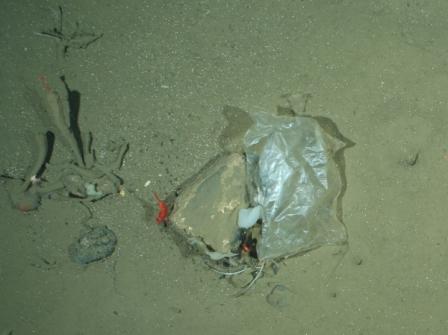
Plastic bag at the HAUSGARTEN, the deepsea observatory of the Alfred Wegener Institute in the Fram Strait. This image was taken by the OFOS camera system in a depth of 2500 m. Photo: Alfred-Wegener-Institut/Melanie Bergmann/OFOS
The question is: how does this waste get up into the Arctic? It could, it seems be part of what, is described as a “garbage patch”, created when plastic waste gets caught up in ocean currents and concentrated into a kind of whirlpool.
Scientists have already identified five of these patches around the globe. The waste in the Arctic appears to be part of a new, sixth “patch” developing in the Barents Sea. What a depressing development! Scientist Melanie Bergman thinks it probably contains waste from the densely populated coastal regions of northern Europe.
“It is thinkable, that some of this garbage drifts north and northwest, as far as the Fram Strait”, she says. Another theory, she says, it that the garbage being found in the Arctic is caused by the retreat of sea ice.
“More and more fish trawlers are following cod further north. Presumably, rubbish from the ships ends up in Arctic waters, either deliberately or by accident. We are assuming that this trend will continue”, says Bergmann.
Climate change and pollution threat
So while here in Bonn, just across the road from my office, the UN climate secretariat is struggling to come up with a draft text for the Paris COP21 summit, which will be acceptable to all parties (and so subject to so many compromises and loopholes?), we have yet another sign of a climate change impact on the no-longer-pristine Arctic. And at the same time, it indicates the effects our unsustainable lifestyles are having on the environment of the planet. I have been witness to many arguments over whether governments should put more effort into combating climate change or environmental degradation and pollution. Ultimately, once more I come to the conclusion that it is virtually impossible to separate the two.
Last week I interviewed two experts on different aspects of ocean protection for a Living Planet special: Oceans under Pressure. They expressed similar views on the intrinsic connections between climate change, humans’ maltreatment of the environment and the health of the oceans on which we rely for survival. Not only are we causing climate change. The other pressures we put on the oceans make it less able to cope.
Tony Long is in charge of work against illegal fishing with Pew Charitable Trusts:
“I think climate change, over-fishing and illegal fishing are all linked in one way or another. The bad practices that occur from illegal fishing can damage the ecosystem, whether it be trawling and ripping up corals, or fishing the wrong species at the wrong time. It all has an effect on the broader ecosystem. And with ocean acidification and the changes that are taking place now scientifically proven, that’s going to reduce the amount of fish people can catch, if we don’t start to look after it. So actually it should all be seen as one”. (Read the interview here).
Ove Hoegh-Guldberg is Director of the Global Change Institute at the University of Queensland, Australian, and chief scientist with the XL Catlin Seaview Survey, which has been monitoring the state of the world’s coral reefs, including the current global bleaching event:
“On our current track where we’re polluting local water, we’re overfishing coral reefs and now we’re rapidly changing the temperature and acidity of the ocean, we won’t have coral reefs and it will be a very long time before they come back – probably well after our exit from the climate. We are the first generation to see these types of impact and we are going to be the last that has the chance to do something. We must get to very low CO2 emission rates as soon as possible, hopefully over the next 20 to 30 years. Because if we don’t – it won’t just be coral reefs. It will be a large number of other ecosystems that go, and humanity will be in trouble.” (Read the interview here.)
I rest my case.
Sharing Arctic ocean data
This week I had an interesting conversation with Professor Karen Wiltshire, who is deputy director of Germany’s Alfred Wegener Institute for Polar and Marine Research. Last time I talked to Karen was on the German North Sea Island of Helgoland, where she is also head of AWI’s Biological Institute. “Jellyfish and chips” is the theme of the article I wrote then about the institute’s research into the impacts of climate change on the North Sea. Tasty?
This time, I was interviewing her on a wider issue, which also has direct relevance to the Arctic. She has taken over the chair of the “Partnership for Observation of the Global Oceans”, or POGO for short, for the next two years. The Directors of the group just had their annual meeting in Tenerife, on the Canary Islands. POGO, Karen told me, is one of the oldest international organizations set up to link partners interested in observing the world’s oceans. It includes all the world’s key marine institutes, including AWI, Woods Hole, Scripps and institutes from China, Korea and Russia.
The directors meet once a year to discuss issues which can be tackled in a coordinated manner. This includes things like research vessels and monitoring marine protected areas.
Exchanging Arctic Data
But one issue which could bring a lot of benefits in particular to scientists working on the Arctic, is the decision taken at the Tenerife meeting to set up a new platform to link up all the long-term ocean data sets in the world. At the moment, Professor Wiltshire says scientists often don’t know of the existence of a lot of data:
“Some of it is very high quality. For example in northern Russia, in the Arctic Ocean, there’s a lot of data that’s not so easily accessible and available. But if our Russian partners just put a flag on the map saying we have this data, and you can come to us if you need it, it would already help us scientists a lot.
“It’s kind of like making a giant inventory of what’s out there, and of what has been measured for the last hundred years. The next step would be to link important oceans with one another, the Arctic and the Atlantic, and look how they have changed relative to one another, and set up hydrographic models linking these oceans. Those models already exist, but with a better data base we might be able to check the rigor of these models, also relative to the melting ice caps. So the first step is to inventorize what’s out there, and then link data sets, variables and ocean areas.”
Russian data is key
This brings me back to conversations I had on my recent Arctic expedition on the RV Helmer Hanssen. Stig Falk-Petersen, the cruise leader, from Norway’s Arctic University of Tromso, stressed to me just how much research on the Arctic has actually been conducted by Russian scientists. In the past, this was rarely translated, so not available to the majority of the international research community. Things have changed since the end of the Soviet Union, Stig told me, and it became easier for western scientists to work with their Russian colleagues.
“And what we discovered then, was that the Russians know all about our famous polar explorers Nansen and Amundsen, but we new nothing about the Russians. Yet the Russians have a fantastic record of science in the Arctic. Since 1937 they have had these drifting stations, they flew out from Novaya Zemlya and landed on North Pole with four engines, Antonov planes, and established an ice camp. And they drifted out the Fram Strait. They have done this nearly every year until recently. So all we know about the Arctic , the topography, situation of water masses, animal life, benthic life, is actually based on Russian expeditions. And this is still poorly known in the west.”
Modern ice drift
Stig is a great fan of a current drift venture, the Fram 2013-2014 expedition, which is more or less repeating that of the first Russian drift station.
The Norwegian scientists Yngve Kristoffersen and Audun Tholfsen are living and working on their ice drift station, including the hovercraft “Sabvabaa”. It was taken and placed on the ice by the AWI’s research vessel the Polarstern, demonstrating once more the benefits of international cooperation in science. The two men have been taking sediment cores to learn about the polar environment more than 60 million years ago. Since August 2014 they have moved northwards along the submarine Lomonosov Ridge. You can follow their progress online at Geonova. Let me just quote a little from their latest diary:
“The length of Lomonosov Ridge ( ̴1.800 km) is roughly equal to the length of Norway. We have now spent 5 months drifting over the Lomonosov Ridge and been able to get new scientific data over a section which constitutes 1/4 of the total length of the ridge. Our drift shows a pattern with periods of very slow ice drift interrupted by events of fast drift. The fast drift is forced by cells of low surface air pressure moving in to the Arctic Ocean over the Canadian Arctic Islands as lately or through the Fram Strait. As they move in, the wind direction drives the ice to the west. These events, unpredictable on a time scale of months, make it impossible to estimate with some degree of confidence where we will be when it is time for Audun to rotate off in late March/April or when we will approach the ice edge in the Fram Strait.”
The data recorded by the scientists is transferred automatically to the Nansen Centre in Bergen. Stig tells me it includes some spectacular underwater videos going right down to the sea bottom, 2000 metres. He and his colleagues are eagerly awaiting a look at the data.

Data from polar orbit satellites is received and processed at KSAT in Tromso. I was able to visit in January. (Pic. I Quaile)
These days, modern technology, from satellite monitoring to a network of buoys moored around the world’s oceans, some with remote data transmission, provide an increasing amount of new data to be shared and analysed. But to understand properly how the oceans are changing, we need data from the past to compare it with. This brings me back to my interview with Karen Wiltshire.
I asked her whether there wasn‘t a danger that research is not able to keep up with the speed of change? Here is her answer:
“There’s very much the danger of that. One of the most important things is having consistent long-term observation. We need to link up old observations, be it whether somebody stood at the end of a dock and measured salinity for a time, in the late 1800s or so, through to now, where we have modern ways of measuring. These things need to be linked and compared to each other to find out whether what you are looking at is related to a real trend or shift, or is just an anomaly in the system. One has to be very mathematically oriented and creative in doing so. Very often, for example in the Wadden Sea, (off the coasts of Germany, Denmark and the Netherlands), we even use historical anecdotes written down in the annals of churches, for example, to look at how the weather was at a certain time, whether we had an ice winter or not. The more information we have from the past, the better it is. Then we’re in a better position to interpret modern-day data, which might be of very short duration in comparison to the long sets of data out there.”
So the new project to link the world’s oceanic data could be a very important step forward. Here’s to success for the latest POGO venture!
You can listen to the interview with Karen Wiltshire on this week’s Living Planet programme, or by itself here.
Ice and mud, glorious mud
Most of the time our ship is out of range of internet connectivity, so this post will be delivered to you from the research base Ny Alesund. My hosts and the station staff were kind enough to arrange a special little boat and a survival suit for a trip through the dark but fascinating polar night. This is only possible because tonight we are still relatively close, with the ship collecting samples in Kongsfjorden, on the north-west side of Spitsbergen. This is an open fjord with a relatively free connection to adjacent shelf. It’s 20 km long, between 4 and 10 metres wide and a maximum depth of 400 metres. This means it is largely influenced by both Atlantic water and Arctic water. It also gets a discharge of fresh water and sediments from adjacent glaciers, which we will be looking at more closely in the next few days. It has been an action-packed day today, watching polar marine night researchers in action. Night research during the day sounds odd, but I can assure you it is certainly dark enough –at any time of day.
Muddy secrets Sergei Korsun from St. Petersburg university and PhD student Olga Knyazeva were out on deck preparing a box corer, a big box-shaped instrument to go down to the seabed and bring up samples of sediment. The teamwork between scientists and crew seems to work brilliantly. The crew operate the lifting and lowering equipment and all sorts of other gear. The scientists collect their samples from it and take them in to the ship’s lab.
“Just a load of mud”, quips Sergei, and there is certainly plenty of it sploshing about in the course of the operation. No wonder there are no outdoor shoes allowed inside.
Olga drains off the water so that only the sediment is left. These two are interested in foraminifera or forams, one-celled organisms. Ice Blog readers may remember I discussed them here some time ago, in connection with research on ocean acidification. German scientists actually wrote a children’s story with Tessi and Tipo, two of these tiny ocean creatures, as the main characters. The focus there was on how increasingly acid seas are dissolving the protective shells of many organisms, especially in cold, Arctic water, where the process is faster. Every creature counts! So why should we be interested in these forams in particular? No question about it, says Olga. There are so many of them, they account for a huge proportion of biomass and we know far too little about what they are up to in the winter. Given their important role in the ecosystem, what they do in winter is something we really ought to know. The season of winter is just too long to be ignored any longer, says Olga. And ultimately, even the tiniest creatures play a role in the global foodweb. Sergei mentions another reason why climatologists and those interested in the history of the planet are so interested in these tiny creatures. They fossilize, so that scientists can use samples from the seafloor to get a record of earth’s history that goes back a very long way.
Inner clocks without daylight? Shortly afterwards, I joined Sören and Lukas from Germany’s Alfred-Wegener Institute for one of their four-hourly net-dropping exercises. For this, a big hatch is opened on the laboratory deck. This brought added excitement as there were a lot of beautifully shaped chunks of ice just floating past. Iceblogger’s delight!
We could also see the hills in silhouette in the background. Clearly there are indeed many shades of “dark”. Seagulls are following us constantly. No doubt they know fish and shrimps are being caught and are always on the lookout for an easy, tasty morsel. In this climate, I don’t blame them. And it is kind of reassuring to have their company, bright in the ship’s lights against the dark sky and sea. The wind felt icy, but the experts up here tell us it is actually relatively mild. Anyway, our two scientists dropped a longish thin net attached to a sort of circular hoop out the hatch, sampling the water.
When it came in, they take samples of small jellyfish, copepods and krill, for a fascinating project to find out about the “biological clock gene”. How can some marine organisms migrate vertically in a 24-25 hour cycle, without light to trigger this? More about that when I’ve interviewed the experts over the next couple of days.
The advantages of winter If you have been waiting for the answer to the question about reproduction in the last blog, I won’t keep you in suspense any longer. Given that the reason is unlikely to be an ideal food supply for the “babies”, some of the scientists on board think the reason could be that there fewer predators about to eat the young, if they arrive in winter. Does that seem plausible? The next post may be a day or two in arriving, as the ship will be out of range from tomorrow onwards. But I promise plenty more to come as soon as we are back in internet range. (How on earth did we live without it?!)
Food and sex in Svalbard’s icy waters?
This is my first post from the Polar Marine Night expedition, from the Kongsfjord in Svalbard.
On the flight from Oslo to Longyearbyen, the main settlement on the island, after a period with a beautiful sunset red strip in the sky, it was dark by half past midday and I realized I had seen my last sunrays for this week.
Flying in to Longyearbyen airport, I could see a white mountain, its dark silhouette outlined by the airport lights. Having been here before in the summer sun, I realized somewhere up there was the famous seed vault where safe supplies of seeds for the world’s food crops are stored under the permafrost, supposedly safe from wars or some other disastrous calamities which might require a “new start” for humanity. I was fortunate enough to visit it on a previous trip a couple of years ago. At the moment, though, the darkness reveals very little of the fascinating landscape.
New winter visitors to Ny Alesund
Our small, robust propeller plane carrying scientists and service staff from the research station, one fellow journalist as well as two young German scientists joining the scientific cruise had us in Ny Alesund late afternoon. It was strange to see the station completely in the dark, although it is not as deserted as it once was in winter, thanks to this Polar Night research. As our driver told us on the way to the harbour, (nothing is far from anywhere else in the small settlement, but hauling luggage across slippery snow and ice in the dark is something I can do without) there are around 60 people on the base, whereas once there was only a skeleton crew of around 13 over the winter.
The French-German station, the Norwegian station and the Chinese building are manned throughout the winter. The others are summer-only stations. Different scientists from around the globe come in and out for the boat trips to investigate marine life in the polar night. This is only the second year of this heightened interest in life in the dark season up here.
Select company of hardy researchers
The RV Helmer Hanssen – named after Amundsen’s navigator to the South Pole – was waiting at the quay. Built as an ice-going fishing vessel, these days the only trawling done here is in the interests of science. Since we left this evening, nets have been deployed at different levels at regular intervals bringing samples of Arctic sea life on board and into the labs. There are 16 students and professors on board, with a crew of 12 to operate the ship, round the clock. It’s an expensive business, says Stig, so they have to make maximum use of the ship time by working to a busy schedule, sleeping in shifts in between. Well, at least we have enough bunks, so we don’t have to economise by sharing those.
Nocturnal goings-on
If I hadn’t done my homework, there were times during the evening briefing by Stig and his colleague Paul Renault, when I might have been tempted to call for an interpreter , with talk of pelagic trawls, the hyper-benthos, grabs, diel vertical migration, epibenthic sleds and more of that ilk. Then comes the high-tech LOPC – a laser optical plankton counter, of course! In case you are not a marine biologist yourself, this is all about getting samples from different layers of water and the seabed to find out about the relatively unknown winter lifestyles and behavior of organisms living in the Arctic ocean. (There was some discussion about supplies of ethanol and formaldehyde, which you must not run out of if you want to take some samples home as a souvenir). It seems amazing, but there is still very little known about marine life in the polar night, because the region was so remote and inaccessible, and because people assumed where there was no light, there would be no biological activity. Now our scientists have discovered (last year was a real “eye-opener”, says Stig) that there is all sorts of activity going on.
It does not surprise me personally that a lot of creatures have to feed all the year round. But what exactly do cod, for example eat? That’s what Marine Cusa wants to find out for her PhD. I met her in the lab, where she was dissecting fish. I had a look inside the stomach of a large specimen of Atlantic cod in the lab.
Not for the faint-hearted, so I won’t go into details. There are even creatures up here who choose to reproduce in this dark season. Now presumably it’s not like with human beings, where there tends to be a rise in the birth-rate after major power cuts in some places. So why would sea creatures choose to have their young in the cold, dark, polar winter? Some of the experts here have some theories – but I’m going to save that for another day.












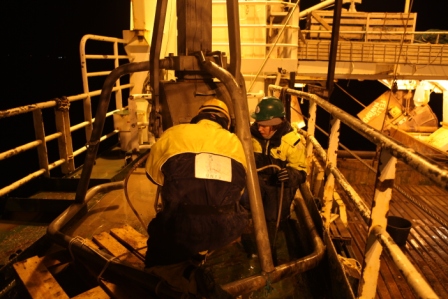








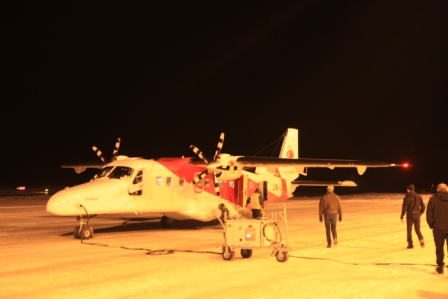
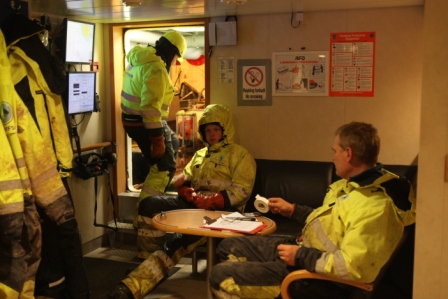
















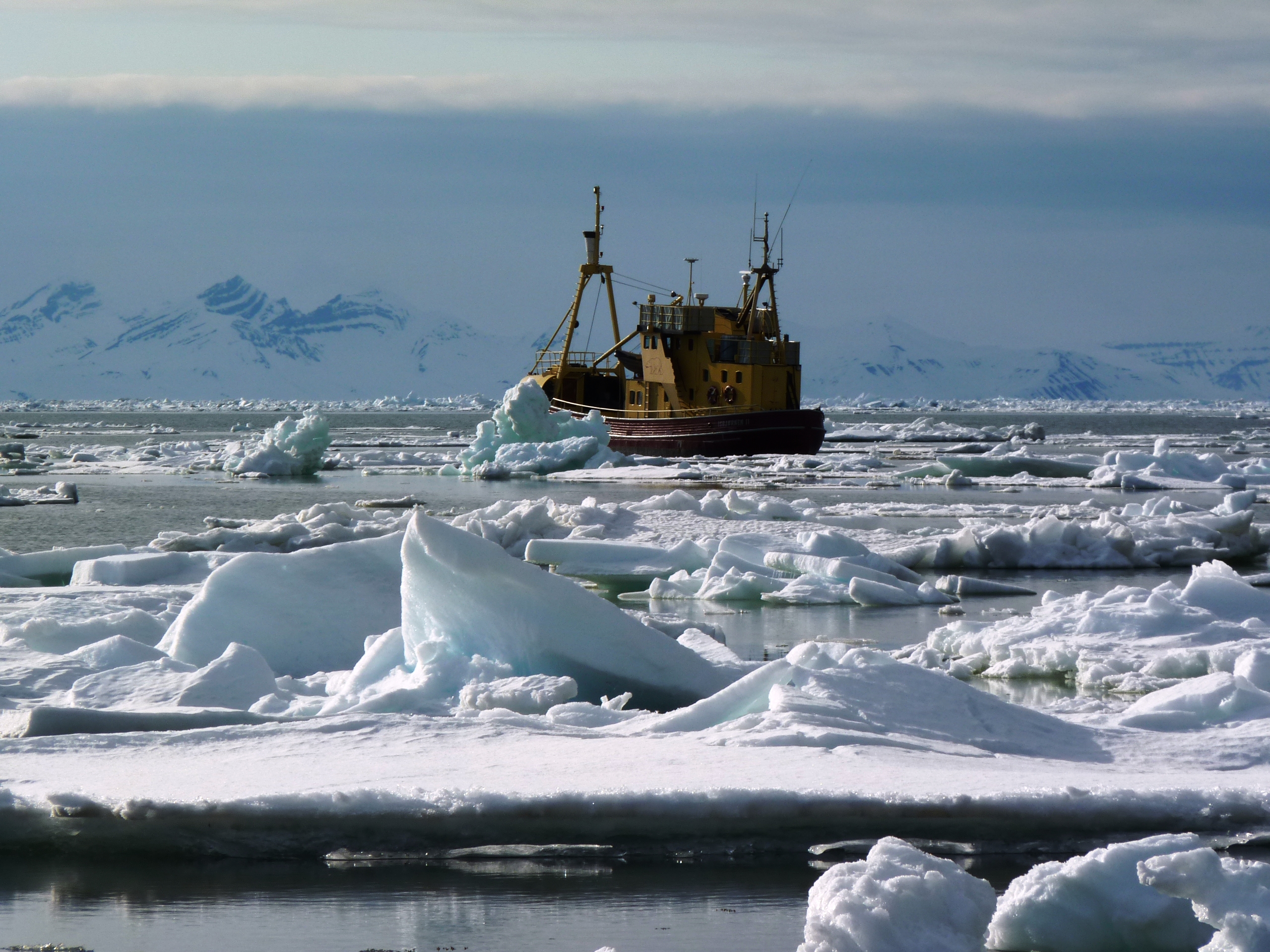


Feedback